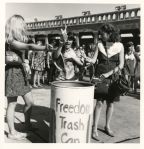Today is the 42d anniversary of the women’s liberation protest at Atlantic City, the event that gave rise to what I call the “nuanced myth” of bra-burning.
Or “bra-smoldering.”
As I discuss in my new book, Getting It Wrong, “bra-burning” is a media myth that has morphed and taken on fresh significance in the years since 1968. “Bra-burning” the epithet has lost some of its sting.
The legend of bra-burning began to take hold in the days and weeks following the women’s liberation protest September 7, 1968, on the Atlantic City boardwalk.
Some 100 demonstrators gathered there, as one participant put it, “to protest the degrading image of women perpetuated by the Miss America pageant,” which took place that night inside the city’s Convention Center.
A centerpiece of the protest was the so-called “Freedom Trash Can” into which demonstrators placed such “instruments of torture” as brassieres, girdles, and high-heeled shoes.
Organizers of the protest have long insisted that nothing was burned during the demonstration.
But my research, as described in Getting It Wrong, found a long-overlooked contemporaneous account in the Press of Atlantic City that said bras and other items in the Freedom Trash Can were set afire that day.
That account was written by a veteran reporter named John Boucher and published September 8, 1968. The account was separately endorsed years later by Jon Katz, who in 1968 was a young reporter for the Press and who covered the women’s liberation demonstration.
“I quite clearly remember the ‘Freedom Trash Can,’ and also remember some protestors putting their bras into it along with other articles of clothing, and some Pageant brochures, and setting the can on fire,” Katz said in an interview with me in 2007. “I am quite certain of this.”
However, the witness accounts of Boucher and Katz don’t lend support to “the far more vivid and popular imagery that many bras went up in flames” in a fiery spectacle that September day, I write.
The legend of bra-burning has endured more than 40 years and, as media scholar Thomas Lieb has pointed out, it seems certain to survive the Baby Boomer generation that propelled it into the public domain.
For many years after 1968, “bra-burning” was a term of scorn and derision, a handy way to dismiss the feminist movement and its goals of gender equality.
As I write in Getting It Wrong:
“Invoking ‘bra-burning’ was a convenient means of brushing aside the issues and challenges raised by women’s liberation and discrediting the fledgling movement as shallow and without serious grievance.”
But as I further write in Getting It Wrong, the term in recent years slowly “has become associated with female empowerment—a metaphor for assertiveness, audacity, and dedication to women’s rights.”
A recent example appeared in the Guardian of London, which referred to bra-burning as a “brilliant … piece of political theatre.”
Another and more puzzling example of bra-burning’s changing significance took place in February 2008 on the Tyra Banks afternoon television show.
I note in Getting It Wrong how “Banks took members of her studio audience into the chill of a winter’s afternoon in New York for a made-for-television stunt about what women could do with ill-fitting brassieres.
“Banks wore an unzipped gray sweatshirt that revealed a powder-blue sports bra. Most of the other women were clad above the waist only in brassieres. They clutched other bras as they stood before a burn barrel from which flames leapt hungrily. On Banks’ word, the women tossed the bras in their hands into the fire.”
More substantively, it is not that unusual to hear female college students these days describe bra-burning as a powerful metaphor for boldness and cheek.
“For many of them,” I write in Getting It Wrong, “‘bra-burning’ has few negative associations. They find little reason to cringe at the epithet.
“Rather, they view ‘bra-burning’ as bold symbolism that connotes a refusal to conform to standards and expectations set by others— sentiments that certainly echo the views of the women who tossed undergarments into the Freedom Trash Can” 42 years ago today.
Related:



[…] introducing us to a time of ladylike sex appeal in music, fashion & style that gave way to burning our bras to be free of ladylike bondage for the bell bottoms & funk of the 70’s, when we decided we wanted our […]
[…] enduring and popular notion of numerous, demonstrative bra-burnings–that female protestors in those days set their bras afire and twirled them over their […]
[…] fact, there was no such “mold.” Bra-burning was a misnomer, inaccurately though relentlessly attached to feminists and the “women’s […]
[…] national panic in October 1938. Yes, there was symbolic bra burning in the Freedom Trash Can at the 1968 protest of the Miss America pageant in Atlantic City, but no mass stripping of undergarments by wild […]
[…] I acknowledge that the evidence of bra-burning at Atlantic City doesn’t correspond to the “widely held image of angry feminists […]
[…] it was more nuanced than that. Bra-burning, at least in a modest, smoldering kind of way, wasn’t such a myth at […]
[…] In a brief item posted online today, the Irish Independent veers toward the latter interpretation. It cites the women’s liberation protest in September 1968 at Atlantic City, a demonstration against the Miss America Pageant that gave dimension to the epithet “bra-burning.” […]
[…] Bra-burning: The morphing of a media myth […]
[…] really a dubious characterization that has morphed into a tiresome cliché. It was not credibly supported by public opinion polling: It was propelled […]
[…] Source: Media Myth Alert […]
[…] commentary ignores evidence offered in my media-mythbusting book, Getting It Wrong, that bras were set afire, if briefly, at the Atlantic City demonstration, which was organized to denounce Miss America as a […]
[…] first-hand accounts are cited in Getting It Wrong that bras and other items were set afire, briefly, at a women’s […]